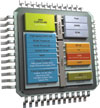

New from NXP Semiconductors are two integrated high-speed CAN Physical Layer transceivers and microcontrollers with easy-to-use on-chip CANopen drivers. Offered as a system-in-package solution, the LPC11C22 and LPC11C24 with integrated TJF1051 CAN transceiver combine complete CAN functionality into a low-cost LQFP48 package.
CAN is recognised as a robust and reliable communication channel for rugged environments. With the introduction of the new devices, NXP is targeting the widespread adoption of low-cost CAN in an increasing variety of industrial and automation applications for factories, buildings and in the home. Typically, CAN transceivers can cost as much as, or even more than, the microcontroller itself. Integrating the CAN transceiver onboard increases system reliability and quality, reduces electrical interconnect and compatibility issues, and reduces board space by over 50% while adding less than 20% to the MCU cost.
The CAN physical layer is designed for up to 1 Mbps high-speed CAN networks and delivers electrostatic discharge (ESD) protection, electromagnetic compatibility (EMC) and low-power operation optimised for industrial applications. The CAN physical layer is fully compliant with the ISO 11898-2 standard for two-wire balanced signalling and is optimised for sensor applications and rugged industrial CAN networks. High ESD handling capability on bus pins is combined with additional fail-safe features such as high DC handling capability on CAN pins, transmit data dominant time-out function, under-voltage detection and thermal protection. Low-power management is fully integrated, and the transceiver can disengage from the bus when it is not powered up.
CANopen drivers are provided in on-chip ROM with easy-to-use APIs enabling users to adopt the LPC11C22/C24 into embedded networking applications based on the CANopen standard. This standardised CANopen layer (EN 50325) is especially well suited for embedded networks in all kinds of control, such as machines and elevators, making proprietary or application-specific application layers obsolete. Incorporating CANopen drivers in on-chip ROM reduces overall risk and effort while providing design engineers with the added advantage of reduced operating power, as well as secure and safe bootloading via CAN. With the security offered by ROM-based drivers, updating Flash via In-System Programming (ISP) over the CAN bus provides the whole range of functionality – from programming blank parts in production, through changing system parameters, to full in-field re-programmability.
The following functions are included in the API:
* CAN set-up and initialisation.
* CAN send and receive messages.
* CAN status.
* CANopen Object Dictionary.
* CANopen SDO expedited communication.
* CANopen SDO segmented communication primitives.
* CANopen SDO fall-back handler.
The LPC11C22 and C24 reportedly require 40-50% smaller code size than 8/16-bit microcontrollers for most common microcontroller tasks. This is enabled by the powerful ARM Cortex-M0 v6-M instruction set, which is built on a fundamental base of 16-bit Thumb instructions unique to 32-bit microcontrollers today. With over 45 DMIPS of performance, the devices provide powerful message and data handling for CAN device nodes together with a power-optimised solution.
| Tel: | +27 11 923 9600 |
| Email: | [email protected] |
| www: | www.altronarrow.com |
| Articles: | More information and articles about Altron Arrow |

© Technews Publishing (Pty) Ltd | All Rights Reserved